|
Ernest Giles Road
 100.6
Kilometres of some of the richest red mystic dusted
roads you will ever travel along. Along the way some
11.3 kilometres is the Henbury Meteorite Conservation
reserve (see below). Further along we found some small
caves/shelters on the right side of the road though
very hard to find. 48 kilometres along you cross the
Palmer River (Seasonal flowing) and here is the turnoff
for the Finke River Track past Boggy Hole to
Hermannsburg. Along this track is the very
isolated Illamurta Springs Conservation Reserve.
Some 52 kilometres further on the road ends at a T road
intersecting with Luritja Road the road joining Uluru
(Ayers Rock) in Kata Tjuta National park and Kings Canyon
in the Watarrka National Park. 13 Kilometres before
Ernnest Giles Road finishes is the turnoff to Tempe
Downs. RAB 100.6
Kilometres of some of the richest red mystic dusted
roads you will ever travel along. Along the way some
11.3 kilometres is the Henbury Meteorite Conservation
reserve (see below). Further along we found some small
caves/shelters on the right side of the road though
very hard to find. 48 kilometres along you cross the
Palmer River (Seasonal flowing) and here is the turnoff
for the Finke River Track past Boggy Hole to
Hermannsburg. Along this track is the very
isolated Illamurta Springs Conservation Reserve.
Some 52 kilometres further on the road ends at a T road
intersecting with Luritja Road the road joining Uluru
(Ayers Rock) in Kata Tjuta National park and Kings Canyon
in the Watarrka National Park. 13 Kilometres before
Ernnest Giles Road finishes is the turnoff to Tempe
Downs. RAB
History
Named after Ernest Giles. The area was little known
to Europeans until recently; Ernest Giles being the
first white man to explore the area in 1872.
Where Is And How To Get To Ernest Giles Road
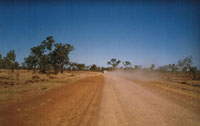 Located
109.8km from Alice Springs, access to the Reserve is
via the Stuart Highway and Ernest Giles Road, or from
Palm Valley via the Finke River 4WD Route. Ernest Giles
road is a dirt road and in some area a heavily corrugated
road so drive slowly. Located
109.8km from Alice Springs, access to the Reserve is
via the Stuart Highway and Ernest Giles Road, or from
Palm Valley via the Finke River 4WD Route. Ernest Giles
road is a dirt road and in some area a heavily corrugated
road so drive slowly.
The Ernest Giles Road and access tracks are unsealed,
sandy and occasionally closed following heavy rain.
The tracks are 4WD only, due to their unstable and changing
road surfaces.
Henbury Meteorites Conservation Reserve
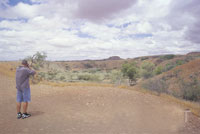 Travel
8 kilometres down the Ernest Giles Road to the access
road turnoff to the north and follow this road for 5
kilometres to the Reserve entrance. The Henbury Meteorites
Conservation Reserve contains 12 craters which are of
national astrogeological importance. They have played
an important part in the scientific study of meteorites
over the past 60 years. Travel
8 kilometres down the Ernest Giles Road to the access
road turnoff to the north and follow this road for 5
kilometres to the Reserve entrance. The Henbury Meteorites
Conservation Reserve contains 12 craters which are of
national astrogeological importance. They have played
an important part in the scientific study of meteorites
over the past 60 years.
Henbury Meteorites Conservation Reserve contains
12 craters
which were formed when a meteor hit the earth's surface
4,700 years ago. The Henbury Meteor, weighing several
tonnes and accelerating to over 40,000 km per hour,
disintegrated before impact and the fragments formed
the craters. The scattered fragments of the Henbury
Meteorite are extremely heavy since they consist mainly
of the metals iron (90%) and nickel (8%).
The scattered fragments of the Henbury Meteorite are
extremely heavy since they consist mainly of iron and
nickel. Pieces of these can be found at the Museum of
Central Australia. Over 500 kilograms of metal have
been found on the site, the largest over 100 kilograms.
Few specimens now exist in the area (which are not to
be taken from the reserve), but the craters are fascinating
attractions providing natural, cultural and scientific
value. Few specimens now exist in the area.
How to Get There - Henbury Meteorites Conservation
Reserve
 Located
145km south west of Alice Springs, the Reserve can be
reached in a conventional 2WD vehicle. At 132 km south
of Alice Springs, along the Stuart Highway there is
a gravel road Ernest Giles Road leading to Watarrka
National Park - Kings Canyon. Travel along this road
for 8 km, then turn north for 5 km to the Reserve's
entrance. Located
145km south west of Alice Springs, the Reserve can be
reached in a conventional 2WD vehicle. At 132 km south
of Alice Springs, along the Stuart Highway there is
a gravel road Ernest Giles Road leading to Watarrka
National Park - Kings Canyon. Travel along this road
for 8 km, then turn north for 5 km to the Reserve's
entrance.
145 kilometres south west of Alice Springs
Recreational Activities - Henbury Meteorites Conservation
Reserve
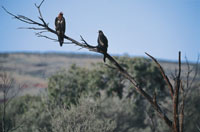 Walking
Tracks - There is a self-guided walking track around
the craters. The largest of the craters is 180 metres
wide and 15 metres deep, while the smallest is barely
recognizable at 6 metres wide and only a few centimetres
deep. Three or four of the craters can be seen very
clearly and inspected at close range. Walking
Tracks - There is a self-guided walking track around
the craters. The largest of the craters is 180 metres
wide and 15 metres deep, while the smallest is barely
recognizable at 6 metres wide and only a few centimetres
deep. Three or four of the craters can be seen very
clearly and inspected at close range.
Visitor Facilities - Henbury Meteorites Conservation
Reserve
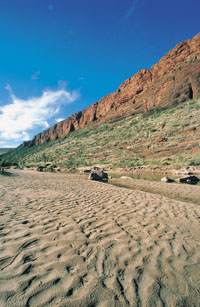 A
camping area with basic facilities is adjacent to the
carpark, visitors must bring their own water and firewood. A
camping area with basic facilities is adjacent to the
carpark, visitors must bring their own water and firewood.
A camping ground with picnic facilities, a pit
toilet and information are available.
There is no drinking water in the area.
Firewood should be collected before entering the Reserve.
Did You Know
Several tonnes of these fragments have been recovered,
many torn and twisted looking like shrapnel. One piece
weighing 44 kg, can be seen in the Spencer and Gillen
Museum in Alice Springs. The distribution of the craters
at Henbury suggests that the meteorite shower came from
the southwest and radiometric age dating techniques
estimates that the craters were formed around, but not
more than 4700 years B.P.
The existence of the Henbury craters has been known
since 1899 when the manager of Henbury station, Mr Park
informed F.J. Gillen of ‘one of the most curious spots
I have ever seen in the country’. Park described the
craters to Gillen but did not know what had caused them
or in fact what the craters were. Park went on to say
‘To look at it I cannot but think it has been done by
human agency but when or why Goodness knows’.
Courtesy
Parks NT
Finke River Track past Boggy Hole to Hermannsburg
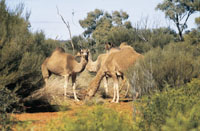 Travelling
along the Ernest Giles Road from the turnoff on road
to Hermannsburg (see map below) is rather very slow
going. It will save you kilometres by not going the
Mereenie Loop but not in time. A suggested site of interest
is www.exploroz.com
© and also there mapping at www.exploroz.com
©. Travelling
along the Ernest Giles Road from the turnoff on road
to Hermannsburg (see map below) is rather very slow
going. It will save you kilometres by not going the
Mereenie Loop but not in time. A suggested site of interest
is www.exploroz.com
© and also there mapping at www.exploroz.com
©.
Boggy Hole Finke Gorge
Boggy Hole Finke Gorge (known just as Boggy Hole or
Boggie Hole to some) is located within the Finke Gorge
National Park due south west of the West MacDonnell
Ranges in the Alice Springs general region. The most
popular attraction or tourist 4WD icon is Boggy Hole,
a permanent billabong courtesy of the Finke River. This
is an interesting and isolated alternative four wheel
drive route to Uluru (Ayers Rock) in Kata Tjuta National
park and Kings Canyon in the Watarrka National Park.
Illamurta Springs Conservation Reserve
This is one of the most peaceful and isolated Reserves
in the Parks and Wildlife Service's estate. It's natural
values are due to the impressive southern foothills
of the James Range and the presence of a permanent natural
spring. The site provides a moist habitat for several
relict aquatic plant species and it protects the ruins
of the Illamurta Springs Police Station.
How to Get There - Illamurta Springs Conservation
Reserve
Located 192km from Alice Springs, access to the Reserve
is via the Stuart Highway and Ernest Giles Road, or
from Palm Valley via the Finke River 4WD Route. The
Ernest Giles Road and access tracks are unsealed, sandy
and occasionally closed following heavy rain. The tracks
are 4WD only, due to their unstable and changing
road surfaces.
When to visit - Illamurta Springs Conservation
Reserve
The Reserve is accessible all year round except after
rain. The cooler months, from April to September, are
the most pleasant times to visit.
Visitor Facilities - Illamurta Springs Conservation
Reserve
Currently there are no
visitor facilities provided at Illamurta
Springs and the use of fire here is prohibited. Camping
is not permitted on the Reserve. Camping
facilities are available at the nearby Ilpurla Aboriginal
Community.
 Tempe
Downs Tempe
Downs
http://www.exploroz.com
|

